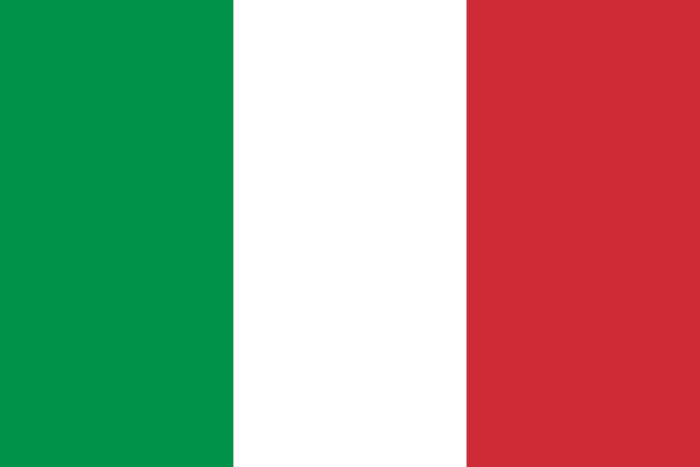
Italian~American Day
11 October 2021

The American Community Survey, compiled between 2008 and 2012 and being the most recent analysis, identified 3% of the total population of Bedford County as descending from Italian ancestors.
Italian~Americans in the United States celebrate Columbus Day as a day of ancestral national pride. Despite the fact that Christopher Columbus sailed across the Atlantic Ocean under the sponsorship of Spain, he was born at Genoa, Italy. Columbus Day was traditionally celebrated by Italian~Americans on the 12th of October. That was the date in 1492 (according to the Julian Calendar) on which Columbus made landfall in the Americas. In the Gregorian Calendar, he would have made landfall on 31 October. For many years the claim was made that Columbus discovered the North American Continent, and to Europeans, that was a fact. But the truth of the matter, as revealed by later archaeological findings, was that other individuals had made landfall on both the North and South American Continents prior to Columbus. In regard to the Eurasian immigrants who had come to North America across the Beringia land bridge about thirteen thousand years ago and gave birth to generations of indigenous Amerindians, the continent had never been lost and therefore was not in need of being discovered. That detail should not deny the fact that to the Europeans, Columbus truly did discover a land of which they had no knowledge.
Columbus Day was celebrated as early as 1792 by the Tammany Society in New York City. President Benjamin Harrison, in 1892, declared the 21st of October to be a holiday honoring Christopher Columbus' arrival in the Americas. Prior to his declaration, there had been many years of anti-Italian sentiment. Harrison hoped to bring that period of discontent to an end. But the anti-Italian sentiment continued into the Twentieth Century. That sentiment did not discourage Italian~Americans; in fact it emboldened them to work harder to have the day declared a federal holiday. In 1934, lobbying by the Knights of Columbus, a Catholic Fraternal Service Order, resulted in Congress passing a statute requesting the President of the United States to issue a declaration for the holiday. The declaration was then made by President Franklin D. Roosevelt. The statute did not establish the holiday as an annual event. Each year the President had to make a similar declaration to keep the holiday active. The National Columbus Day Committee was formed in 1966 and its leader, Mariano A. Lucca was successful in having the observance declared a federal holiday in 1968.
Basil M. Russo, the National President of the Order Italian Sons and Daughters of America, recently noted that: "Columbus Day is not a day that's set aside to honor an individual, but rather is a day that's set aside to recognize and honor a monumental historic event that began the process of over 500 years of worldwide immigration to America by oppressed people seeking a better life for their families..."
Italian~Americans celebrate holidays such as Columbus Day with community gatherings and meals. The meals, in which each family brings a favorite dish to share with everyone else, are called potlucks. Sometimes they are referred to as covered dish dinners suggesting that the food be casseroles or other foods baked in the oven. Speaking of Italian food, the dishes that are thought to be 'traditional' Italian dishes may have got their start on the Italian peninsula, but the forms they have evolved into today owe their variety to their spread throughout the world and the influences of local methods and ingredients.
Italian~Americans celebrate holidays such as Columbus Day with community gatherings and meals. The meals, in which each family brings a favorite dish to share with everyone else, are called potlucks. Sometimes they are referred to as covered dish dinners suggesting that the food be casseroles or other foods baked in the oven.
There are two things that must be mentioned about Italian cuisine before the particular dishes are described. Many Italian dishes are based around one of 180 different types of pasta and one of fifteen types of sauces. The dishes that are thought to be 'traditional' Italian dishes may have got their start on the Italian peninsula, but the forms they have evolved into today owe their variety to their spread throughout the world and the influences of local methods and ingredients.
Perhaps the most famous and beloved Italian dish, Spaghetti, is made from thin, solid strands of pasta. The diameter of a single strand of Spaghetti (which coincidently is called a 'spaghetto') is about one-sixteenth of an inch. A normal helping per person would be a bunch measuring about an inch in diameter. The strands of spaghetti are boiled in a pot of water for between eight and ten minutes to reach the 'al dente' state, which translates as 'to the tooth' and meaning it will be soft enough to be chewed easily but still firm enough that it is not mushy. Even though al dente is the desired firmness, when boiling spaghetti for eight to ten minutes the strands sometimes become sticky and cling to each other. A trick that some people employ when boiling spaghetti is to add just a little (such as a tablespoon) of cooking oil to the pot. Salt is also added to the water in which spaghetti is boiled because pasta absorbs salt and it will add a salty flavor to the pasta.
Spaghetti, like other pasta dishes, can be made with or without sauce, and the types of sauce vary widely depending on whether other ingredients, such as meatballs, mushrooms and bell peppers are added to it. Salsa fi Pomodoro, or traditional tomato sauce used for spaghetti consists of a mixture of tomatoes with roux (a combination of pork fat and flour), along with any number of spices, which is simmered for hours until it reduces down to a thick sauce. Marinara sauce consists of tomatoes boiled with garlic, crushed red pepper, basil and oregano. Marinara is therefore thinner than actual tomato sauce. Alliums, such as garlic, onion, leeks, shallots and chives can be used to flavor spaghetti and other pasta dishes. Spices which go well with tomatoes, such as basil and oregano, are often added to the sauce used in spaghetti. Some people, especially children, seem to like spaghetti only with butter melted over it. Spaghetti might be prepared with a tomato based sauce for Ragu Alla Bolognese or with bechamel, a creamy white sauce made of flour, butter and milk for Rigatoni. Baked Spaghetti is enjoyed by many when the sauce is Alfredo, made with cream cheese, heavy whipping cream, butter, garlic and parmesan cheese. Speaking of parmesan cheese, grated parmesan tends to be sprinkled over spaghetti by many in the United States.
Lasagna is another pasta favorite. The dish consists of alternating layers of pasta, cheese, meat and sauce.'Vegetable' lasagna is made by substituting diced or chopped vegetables with the layer of meat in regular lasagna. A variation of lasagna is baked Ziti, made with ricotta cheese or sour cream and provolone cheese. For chicken or veal lovers, an Italian~American cook will cover the meat (which can also be breaded) with a tomato-based or marinara sauce and top it with parmigiana cheese and bake it to make Chicken Parmigiana or Veal Parmigiana.
One cannot speak of Italian food and not mention Pizza. Okay, but first to deal with the 5,000 pound elephant in the room ~ did pizza actually originate in China rather than Italy? The answer is 'maybe yes, maybe no, who knows?' Pizza-like dishes have been found to have been eaten in ancient Egypt, ancient China, ancient Greece and even ancient Rome. All forms of the dish employed a flatbread with toppings. The only differences in the dish from one region to another, since ancient times, has been in the ingredients that are placed on top. Traditional Italian pizza consists of a flattened dough base onto which are placed diced tomatoes, crumbled cheese, such as feta, and olives and all dusted with oregano, basil and other herbs. Italian~Americans tend to follow their ancestral recipes. Commercial pizza companies have opted for a pizza sauce covering the flatbread with cheese (usually mozzarella) solidly covering the sauce. And at the very top are whatever toppings the customer wants, including meats such as pepperoni, sausage, bacon, chicken and ham; vegetables such as mushrooms, onions, peppers and olives; and even seafood such as shrimp, oysters and anchovies. Pizza companies are constantly trying to 'one-up' their competition and in order to do so, a number of variations to the basic recipe have become popular. Those variations include varying the thickness of the crust and stuffing cheese and even pepperoni in the crust. Two variations of pizza meriting their own names are Calzone and Stromboli. Both dishes can be thought of as pizza folded over on itself. Calzone is simply folded in a half-circle shape. Calzones might contain just ricotta cheese with marinara sauce on the side to be dipped. Stromboli is rolled in a spiral and often contains mozzarella and sauce baked inside it along with other ingredients such as bell peppers, onions and any variety of meats. Calzone originated in Naples, Italy in the 18th Century while Stromboli originated in the 1950s in Philadelphia.
By enclosing meat and/or cheese in pasta pockets and boiling them, and then covering them with a sauce, one gets Ravioli. So what were the traditional fillings and sauce for ravioli? That is a question that is difficult to answer. The dish has always varied from region to region. At the region known as Emilia-Romagna, where some of the earliest civilized communities sprang up out of Etruscan roots, ravioli consist of pasta filled with ricotta and spinach. In northern Italy the filling consists of baked fish mixed with eggs, grated parmigiana cheese and herbs such as garlic, marjoram and parsley. The ravioli are covered with a sauce made with shrimp, mussels, clams and calamari. At Calabria, in the southern tip of Italy, the ravioli is composed of pecorino (a hard cheese made from sheep's milk), eggs, provolone cheese and soppressata (dry salami) covered with a tomato sauce to which minced pork, chili, carrot, onion and garlic are added. At Abruzzo, along the east coast of Italy, the ravioli contains a filling of ricotta and pecorino cheeses mixed with egg yolk, lemon, cinnamon and sugar. The ravioli are topped with diced tomatoes, onions, celery and carrots sauteed together. And finally, at Sardinia, the island to the west of the Italian peninsula, ravioli varies even from town to town. One of the unique recipes calls for pasta filled with potato and onion flavored with mint. The ravioli are covered either with tomato sauce and grated pecorino or simply olive oil and mushrooms. It should be noted that no matter what fillings and sauces are employed, ravioli are sometimes called 'dumplings'.
Pane is the Italian word for bread. And anyone, of Italian ethnicity of otherwise, is well acquainted with the tradition of homemade bread at Italian restaurants. Bread in Italian cuisine qualifies as a dish in itself. Panini refers any sandwich made with homemade bread, often grilled or toasted. Focaccia is a flatbread similar to that used for pizza. And, as with Spaghetti and Ravioli, there are regional variations under the same name. In some regions focaccia is made as a hard flour biscuit and in others as a soft cornbread. In some regions the focaccia has a layer of crescenza cheese between two thin layers of dough. In others, the dough is topped with either sauce or meat. No matter how it is made, focaccia usually is flavored with rosemary or sage. Ciabatta is a somewhat recent addition to Italian cuisine, having been created in 1982 by a baker in Veneto, Italy to compete with French baguettes in the market place. The bread is white flour dough into which is mixed olive oil, salt, water and yeast and then baked. Pita is a yeast-leavened flatbread that is round and flat. Pita is baked at high temperatures which causes the water in the dough to turn to steam. The steam builds up inside the dough causing it to puff up and create a pocket. Pita is traditionally torn apart by hand and used to scoop up dips, such as hummus. Crescentina is a type of bread consisting of flour, water and lard. Sometimes the water is replaced by milk to produce a softer loaf. Crescentina is fried as compared to being baked. Usually, small quantities of the dough is used to produce single sandwich sized loaves.
A number of soups and stews have Italian origins. There are a few that are so well known that many people probably fail to realize that they are Italian soups. The name Minestrone refers to a thick vegetable soup. Its ingredients vary from town to town and from household to household. Depending on what you have on hand, minestrone might consist of only vegetables or it might include meat. Some families build the soup around beans of some sort while other leave out beans altogether. One ingredient that most recipes for minestrone include is pasta. That pasta can be spaghetti or shells. Rice can substitute for the pasta. A basic recipe starts with cooking some pancetta, or bacon, in olive oil. Beans and potatoes and some tomatoes and parmesan cheese rinds are added to the bacon drippings to be sauteed. Into a pot of beef stock are added the sauteed vegetables. After about a half hour of simmering, peas are added. Lemon juice and salt and pepper add additional flavors. Pasta is then cooked, strained and added to the pot. Then there is the Italian Wedding Soup, which actually includes the name 'Italian' in its name. While most people assume that this soup is served at weddings, nothing could be farther from the truth. Granted, Italian Wedding Soup could be served at a wedding if the party wants it to be, but the name is derived from the Italian name, 'minestra maritata.' That translates as 'married soup,' meaning that the flavors of greens are combined with meats. Into a chicken stock or broth are added any type of greens, such as endive, spinach, kale, cabbage or lettuce and either sausage or meatballs. A less well-known soup is Garmugia. This soup consists of either vegetable or chicken stock into which is added artichoke hearts, asparagus, fava beans, carrots, onions and peas. Veal, bacon or sausage is added in small amounts just to add a slight bit of flavor.
Two dishes that would be classified as dips or sauces should be mentioned before closing this article. Pesto is prepared by crushing garlic and pine nuts in a mortar and pestle to a cream consistency. Basil leaves and coarse salt are added to the mortar and crushed into the garlic and pine nut cream. Pecorino (sheep's milk cheese) and Parmigiano-Reggiano (a hard cow's milk cheese) are added to the cream along with a little extra-virgin olive oil. Pesto is usually added to other dishes or spread on bread. The other dish that is more or less a sauce is Maccu. Maccu is made by crushing fava beans and fennel seeds and mixing in olive oil. The fennel gives it a licorice flavor. Although that is the basic recipe, tomatoes, onions and pasta may be added to the mixture. Maccu is sometimes left to cool and harden. It is then cut into strips, breaded in flour and fried in olive oil.
Italian~Americans are not known to favor beer like their German or Irish neighbors. Their pasta dishes are better paired with Wines and mixed-alcoholic drinks. Wines, such as Chianti and Barbera are very popular among both Italians and Italian~Americans. Aperitifs, or mixed-alcoholic drinks, drank before a meal, will stimulate the appetite. Certain liqueurs used both in cooking and in cocktails, such as Campari and Amaretto, evoke the spirit of Italy like no others. Campari's primary flavor is bittersweet orange, while Amaretto's is almond. Sambuca is an anise-based liqueur which has a strong licorice flavor. Certain liqueurs, such as Vespetro are made from a variety of spices and therefore have exotic flavors.
Additional Information Might Be Added Here. Please Check Back.
Click on this logo to return to the Calendar page.

